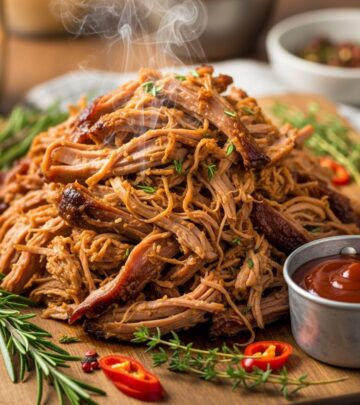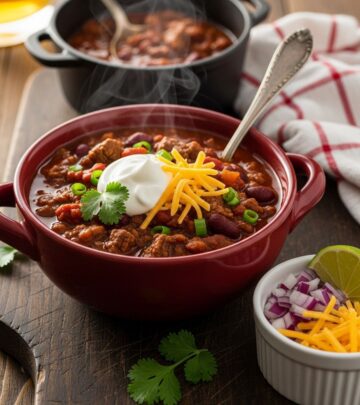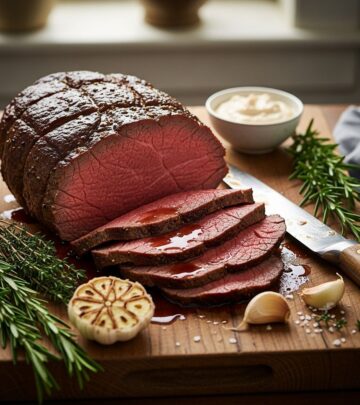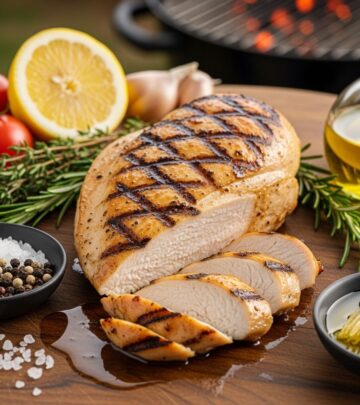Beef Pot Roast Recipe: Complete Guide To Classic Comfort Food
Discover rich flavors and tender delights in a timeless dinner that warms the soul.

Image: HearthJunction Design Team
Classic Beef Pot Roast: The Ultimate Comfort Food Guide
There’s something deeply satisfying about a perfectly cooked beef pot roast. This classic comfort food has earned its place as a staple on dinner tables across America, especially for Sunday family gatherings and special occasions. The beauty of pot roast lies in its simplicity – a tough cut of beef transformed through slow cooking into a tender, flavor-packed meal that feeds a crowd with minimal effort. In this comprehensive guide, we’ll walk through every aspect of creating the perfect pot roast, from selecting the meat to serving suggestions that will have your family requesting this dish again and again.
What Makes a Great Pot Roast?
The perfect pot roast strikes a beautiful balance – meat so tender it practically falls apart with the touch of a fork, vegetables infused with rich meaty flavor, and a gravy that ties everything together in savory harmony. What began as a practical way to make tough, inexpensive cuts of meat delicious has evolved into an art form that combines simple ingredients with time-honored techniques.
A truly exceptional pot roast isn’t rushed. The magic happens during the long, slow cooking process, as collagen in the meat breaks down into gelatin, creating that signature melt-in-your-mouth texture. Meanwhile, the vegetables and seasonings infuse the meat and cooking liquid with layers of flavor that simply can’t be achieved through quick-cooking methods.
Choosing the Right Cut of Meat
The foundation of any good pot roast is selecting the right cut of beef. Contrary to what you might expect, the best cuts for pot roast aren’t the expensive, tender steaks but rather the tougher, more economical cuts that come from well-exercised parts of the cow.
Recommended Cuts for Pot Roast
These cuts contain significant amounts of connective tissue and collagen that, when cooked slowly, break down to create tender, flavorful meat:
- Chuck Roast: The most popular choice for pot roast, chuck comes from the shoulder area of the cow. It has excellent marbling (flecks of fat throughout the meat) that melts during cooking, keeping the meat moist and adding flavor.
- Brisket: From the breast or lower chest of the cow, brisket has a lot of connective tissue. It can be slightly fattier than chuck and requires careful trimming.
- Bottom Round or Rump Roast: Leaner than chuck, these cuts come from the rear of the cow. They can still make excellent pot roast but might not be quite as tender as chuck.
- Top Round: Another lean cut that works well but benefits from slightly more careful temperature control to prevent drying out.
For this classic recipe, we recommend a 3-4 pound boneless beef chuck roast. Look for one with good marbling throughout, as this fat will render during cooking, adding moisture and flavor to the final dish.
Essential Equipment for Perfect Pot Roast
While pot roast doesn’t require fancy equipment, having the right cooking vessel makes a significant difference in your results. Here are the options to consider:
Dutch Oven (Recommended)
A heavy Dutch oven is ideal for pot roast for several reasons:
- The heavy construction distributes heat evenly
- It can go from stovetop (for searing) directly to oven (for slow cooking)
- The tight-fitting lid traps moisture, creating a perfect environment for braising
- The enameled surface makes deglazing easy, capturing all the flavorful brown bits
Alternative Cooking Methods
If you don’t have a Dutch oven, consider these alternatives:
- Slow Cooker: Offers convenience but you’ll need to sear the meat in a separate pan first for best results
- Heavy Roasting Pan: Can work well with foil tightly sealed over the top
- Pressure Cooker/Instant Pot: Speeds up the process considerably but requires some adjustments to the recipe
Classic Beef Pot Roast Recipe
Ingredients
- 3-4 pound boneless beef chuck roast
- 2 tablespoons vegetable oil or olive oil
- 1 large onion, sliced
- 3-4 cloves garlic, minced
- 2 bay leaves
- Salt and freshly ground black pepper to taste
- Optional: carrots, potatoes, celery, or other root vegetables
Preparation Steps
- Prepare the Meat: Take the chuck roast out of the refrigerator 30-45 minutes before cooking to allow it to come to room temperature. This ensures more even cooking. Pat it dry thoroughly with paper towels – this is crucial for achieving a good sear.
- Season Generously: Season all sides of the roast liberally with salt and freshly ground black pepper. Don’t be shy with the seasoning; this is a large cut of meat.
- Preheat: Position your oven rack in the lower third of the oven and preheat to 325°F (165°C).
Cooking Method
- Sear the Meat: Heat oil in a Dutch oven over medium-high heat until it’s shimmering but not smoking. Place the seasoned roast in the center of the pot and let it sear undisturbed for about 4 minutes, until deeply browned. Using tongs, rotate and sear each side for 3-4 minutes until the entire roast has a rich brown crust. This browning process is essential for developing flavor.
- Remove and Prepare Aromatics: Transfer the seared roast to a plate. In the hot Dutch oven, arrange sliced onion, minced garlic, and one bay leaf. Season with a pinch of salt and pepper.
- Return the Roast: Place the seared meat back in the Dutch oven, on top of the aromatics. Position the second bay leaf on top of the meat.
- Cover and Roast: Put the lid on the Dutch oven and place it in the preheated oven. Cook at 325°F for 30 minutes, then reduce the temperature to 300°F (150°C) and continue cooking for approximately 1½ hours more, until the meat is fork-tender.
- Check for Doneness: The roast is ready when a fork easily penetrates the meat or an instant-read thermometer inserted into the thickest part reads 145°F (65°C) for medium doneness. The meat should be very tender but not falling apart completely.
- Rest Before Serving: Transfer the finished roast to a platter and let it rest for 10-15 minutes before slicing. This crucial step allows the juices to redistribute throughout the meat.
Adding Vegetables to Your Pot Roast
While the classic recipe focuses on the meat itself, many home cooks prefer to make pot roast a complete one-pot meal by adding vegetables. Here’s how to incorporate them successfully:
When to Add Different Vegetables
Different vegetables require different cooking times, so add them at the appropriate stage:
- Root Vegetables (Carrots, Parsnips, Turnips): Add these heartier vegetables about 45-60 minutes before the roast is done.
- Potatoes: Medium-sized, quartered potatoes can go in 45-60 minutes before finishing.
- Mushrooms: Add 30 minutes before the roast is done.
- Peas or Green Beans: These tender vegetables need only 10-15 minutes of cooking time.
Creating a Delicious Gravy
A rich, flavorful gravy is the perfect complement to pot roast. Here’s how to make it from the cooking liquid:
Basic Pot Roast Gravy
- After removing the cooked roast and vegetables, strain the cooking liquid to remove any solids or bits of fat.
- Return the strained liquid to the Dutch oven and bring to a gentle simmer over medium heat.
- To thicken: Mix 2 tablespoons of cornstarch or flour with 3 tablespoons of cold water to create a slurry. Whisk this mixture into the simmering liquid.
- Continue stirring until the gravy thickens to your desired consistency, about 3-5 minutes.
- Taste and adjust seasoning with salt and pepper if needed.
Serving Suggestions
The classic way to serve pot roast is to slice it against the grain into thick pieces, arrange on a platter surrounded by the vegetables, and drizzle everything with gravy. However, there are many delicious ways to enjoy this versatile dish:
- Serve over mashed potatoes, egg noodles, or rice to soak up the delicious gravy
- Accompany with crusty bread or dinner rolls for dipping
- Add a fresh side salad with a vinaigrette dressing to balance the richness
- Include a side of cranberry sauce or applesauce for a sweet-savory contrast
Storage and Reheating Tips
One of the best things about pot roast is that it often tastes even better the next day, after the flavors have had time to meld. Here’s how to store and reheat your leftovers:
Storage
- Refrigeration: Store cooled pot roast with gravy in an airtight container in the refrigerator for up to 4 days.
- Freezing: For longer storage, freeze pot roast in freezer-safe containers for up to 3 months. Consider freezing the meat and gravy separately for best quality.
Reheating
- Oven Method (Best for preserving texture): Place pot roast and gravy in an oven-safe dish, cover with foil, and heat at 325°F until warmed through, about 20-30 minutes.
- Stovetop Method: Slice the cold pot roast and gently reheat in gravy in a covered skillet over low heat until warm.
- Microwave (Quickest method): Use medium power and short intervals, stirring in between, to prevent the meat from becoming tough.
Frequently Asked Questions (FAQs)
Q: Why is my pot roast tough?
A: Tough pot roast usually means it hasn’t cooked long enough. Unlike steaks, pot roast cuts need long, slow cooking to break down connective tissues. If your roast is tough, return it to the oven at 300°F and check every 30 minutes until fork-tender.
Q: Can I make pot roast ahead of time?
A: Absolutely! Pot roast actually improves with time as flavors meld. Make it a day ahead, refrigerate, and remove the hardened fat from the surface before reheating. Warm gently in a 325°F oven until heated through.
Q: What’s the difference between pot roast and beef stew?
A: Pot roast typically uses a single large cut of meat cooked whole, while beef stew uses meat cut into smaller cubes. Pot roast is usually served sliced with gravy, while stew has more liquid and is served as a thick soup.
Q: Can I make pot roast in a slow cooker?
A: Yes! Sear the meat first in a skillet, then transfer to a slow cooker with the other ingredients. Cook on low for 8-10 hours or high for 4-5 hours until tender.
Q: What wine pairs well with pot roast?
A: Full-bodied red wines like Cabernet Sauvignon, Merlot, or Syrah complement pot roast beautifully. The robust flavors stand up well to the richness of the dish.
Conclusion
Mastering the classic beef pot roast is a culinary achievement that pays dividends in delicious family meals and treasured memories around the dinner table. By understanding the fundamental techniques – selecting the right cut, searing properly, and cooking low and slow – you’ll create a dish that’s greater than the sum of its simple parts. Whether you’re making pot roast for a special Sunday dinner or a comforting weeknight meal, this timeless recipe is sure to become a favorite in your household’s regular rotation.
References
- https://www.allrecipes.com/recipe/14621/beef-pot-roast/
- https://www.allrecipes.com/i-tried-our-best-pot-roast-recipes-8735816
- https://www.allrecipes.com/recipe/218547/slow-cooker-pot-roast/
- https://www.allrecipes.com/easy-pot-roast-recipe-8706184
- https://www.allrecipes.com/recipe/16346/maries-easy-slow-cooker-pot-roast/
Read full bio of Anjali Sayee












